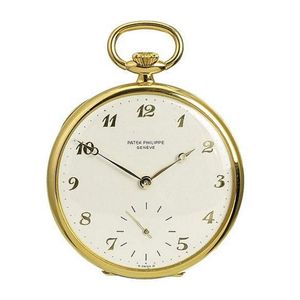Patek Philippe 18ct Gold Openfaced Watch, 1988
You must be a subscriber, and be logged in to view price and dealer details.
Subscribe Now to view actual auction price for this item
When you subscribe, you have the option of setting the currency in which to display prices to $Au, $US, $NZ or Stg.
- Movement - The technical name for the workings of a clock or watch, and does not include the dial or case.
- Lever Escapement - A lever escapement is a type of escapement mechanism used in mechanical clocks and watches to regulate the timekeeping of the movement. It was invented by British clockmaker Thomas Mudge in the 18th century and is now widely used in modern mechanical timepieces.
The lever escapement consists of three main parts: the escape wheel, the pallet fork, and the lever. The escape wheel is a wheel with teeth that is driven by the clock or watch's main spring or weight. The pallet fork is a two-pronged component that is positioned so that it can engage with the teeth of the escape wheel, and the lever is a small, L-shaped component that is attached to the pallet fork.
When the escape wheel turns, one of its teeth pushes against one of the pallet fork's prongs, causing the fork to pivot. As the pallet fork pivots, it releases the tooth and engages with the next tooth on the opposite side of the escape wheel. At the same time, the lever, which is connected to the pallet fork, rocks back and forth, allowing the escape wheel to turn at a regulated rate.
The lever escapement is prized for its accuracy and reliability and is commonly used in high-end mechanical watches. It allows for precise timekeeping by ensuring that the movement of the watch or clock is regulated and consistent, and its compact size makes it an ideal choice for use in small, portable timepieces.
This item has been included into following indexes:
Visually similar items

A gold open faced duplex pocket by James McCabe London, 18ct yellow gold, presented with engraved case, white enamel dial, slender Roman numerals, gold hands, sub dial, crown wind, dial marked 4662. Case hallmarked IMC 4662. Tw London 1900 18ct. Movement s

A Waltham rolled gold open face pocket watch, white enamel dial, Roman numerals, subsidiary seconds on a stem wind and set plate movement signed A.W.W.Co. Waltham Mass. Size 50 mm. C 1898.

An 18ct. gold cased pocket watch, open face with a white enamel dial, Roman numerals, railtrack minutes and subsidiary seconds, the lever wind movement signed J.B. Yabsley, 72 Ludgate Hill, London, gold dust cover, hallmarked back cover. Case weight (incl.

A William IV silver consular case pocket watch by Jos Bates, Huddersfield, hallmarked London 1831. Fusee and chain drive movement. N.14214. Faint hairlines.
